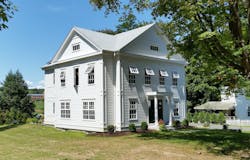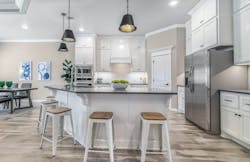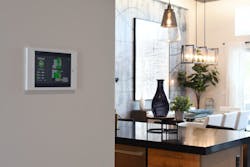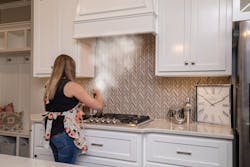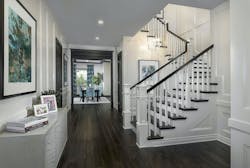Of the various building concepts and practices to have made their way through the industry over the years—aging in place, universal design, energy efficiency, green building, and sustainability, among others—some have gained traction with builders and consumers and some are now required by code.
While the idea that homes can be healthy places that nurture their inhabitants and promote wellness isn’t new, that idea is now being more sharply defined and codified in ways that could change building practices and further heighten consumer awareness—especially in light of the COVID-19 health crisis and people’s need to do more tasks at home.
RELATED
- Wellness on a Grand Scale
- 4 New Live/Work Housing Design Solutions
- Net Zero Energy: The Ultimate Z.E.N. Home's Indoor Air Quality System
Defining Healthy for Homes
The "healthy homes" discussion seems to be fed from two sources.
One is the realization that while stricter energy-efficiency requirements result in tighter homes that offer reduced air infiltration and thermal transfer, paying attention to best practices for fresh air ventilation and filtration may be lax, subjecting occupants to poor (read: unhealthy) indoor air quality (IAQ). Recent studies have shown poor IAQ can lead to health issues, exacerbate existing medical conditions, and negatively affect school and work performance.
The second source is part of a larger discussion of “wellness.” For at least a decade, builders and designers have been speaking about and responding to homebuyers’ desires for indoor-outdoor connectivity, more natural light, and community amenities such as gyms, spas, hiking and biking trails, and other elements that promote physical and emotional wellness.
But wellness—defined by the Global Wellness Institute (GWI) as “the active pursuit of activities, choices and lifestyles that lead to a state of holistic health” and communities proactively designed and built to support the holistic health of their residents—is an unwieldy concept for builders to deliver in their homes and articulate in their marketing. Still, GWI estimates that wellness-driven real estate is a $134 billion industry.
Home builders seeking to create healthy homes tend to focus on systems—particularly HVAC equipment efficiency and design—and building materials that emit fewer (or no) volatile organic compounds (VOCs). Some may also invest in next-level filtration or controlled fresh-air ventilation systems.
“Keeping people healthy shouldn’t be an option when purchasing a home. Our health-based program is standard in every one of our homes at every price point across the country.” —CR Herro, VP of innovation, Meritage Homes
Meritage Homes, which closed 9,267 homes in 2019 priced from $200,000 to $1 million across the South and West, promotes better IAQ with systems that “bring in filtered fresh air so family activities that occur in the home don’t accumulate harmful materials,” says CR Herro, the builder’s VP of innovation.
Meritage also specifies materials that don’t off-gas VOCs and installs systems that maintain ideal indoor humidity to help mitigate mold spore growth. “Keeping people healthy shouldn’t be an option when purchasing a home,” Herro says. “Our health based program is standard in every one of our homes at every price point across the country.”
While not included in the “HVAC” acronym, air filtration is gaining traction as an essential (and thoughtful) piece of the IAQ puzzle. “You can’t just put in an air filter and say, ‘We’re good to go,’” says Michael Trolle, co-founder of BPC Green Builders, a custom home builder in Wilton, Conn. “What size particle level are you filtering to? What’s the outside air quality like? What if the majority of pollutants are being generated inside the house?”
Programs and Options for Healthy Homes
For builders looking for the right science-based answers, Indoor airPLUS , a voluntary certification and labeling program administered by the U.S. Environmental Protection Agency (EPA), requires certain construction practices and product specifications that help minimize exposure to airborne pollutants and contaminants, says EPA specialist Nicholas Hurst.
Those specifications focus on moisture management, HVAC systems, radon-resistant construction systems, low-emitting materials, pest prevention, and managing pollutants from combustion, among other aspects of ensuring healthy indoor air.
Dennis Webb, VP of operations at Fulton Homes, in Phoenix, says the company began following Indoor airPLUS guidelines and standards in 2014 after becoming aware of an oft-quoted EPA statistic that Americans spend 90% of their time indoors, where the concentrations of some pollutants can be two to five times higher than outdoor concentrations.
“[W]e wanted a way to differentiate ourselves from other builders in town,” and indoor air quality was the key. —Dennis Webb, VP of operations, Fulton Homes
Fulton, which closed 886 single-family units in 2019 ranging in price from $225,000 to $700,000, was already building homes certified by the federal Energy Star program, Webb says. “But we wanted a way to differentiate ourselves from other builders in town,” and indoor air quality was the key.
For new construction, specifying low-VOC paints, flooring options, cabinets, and a better HVAC system doesn’t add significant cost ... especially if cost efficiencies can be found elsewhere.
“If builders approach this in a silo manner, it can cost more, but if they approach the house as a collection of systems and consider how those systems interact with each other, then there’s little added cost,” says John Barrows, owner of P3 Builder Group, on Long Island, N.Y.
He cites structural insulated panels (SIPS) as an example. Barrows uses SIPs 95% of the time for his homes, and while they cost more per linear foot than a pile of sticks, he says he saves in labor costs by not paying to install insulation after the home is framed. And because the home is so tightly built with SIPS, he can spec a smaller (and therefore less expensive) HVAC system.
Homes By Taber, in Oklahoma City, focuses on delivering homes with “healthy home technology,” says director of marketing Lindsay Haltom, including a MERV-13 air-filtration system, low-VOC paints, and “stovetop ventilation through the roof.”
That package, among other features, is standard in the approximately 400 homes Taber closes per year, ranging in price from $220,000 to $450,000. “We have $80,000 in features that other builders in our area would consider an upgrade,” says Haltom, a cost significantly lowered by the builder’s purchasing power.
Indoor Air Quality, According to Darwin
In recent years, there’s been a smart addition to the IAQ mix: the Darwin system, “a wellness brain center for the home covering water, air, and circadian-rhythm lighting,” says Paul Scialla, founder and CEO of Delos, a New York-based wellness innovation company that developed the technology. Scialla is also the founder of the International Well Building Institute, a public benefit corporation that offers its own Well Building Standard for healthy home certification.
Darwin operates as a wellness intelligence network for the home. If pollutant levels are harmful, the system activates filters to remediate the indoor air and reduce those levels. Scialla says Darwin is most helpful with the piece builders can’t control: what consumers bring into their homes that may negatively affect indoor air quality.
Launched in 2018 for a new development of 1,000 entry-level homes in Australia, the Darwin system added about $2,000 to each home’s construction costs, Scialla says, and about a 1% premium on sales prices in the $200,000s.
From that experience, Darwin’s performance and relatively low cost attracted KB Home, the nation’s seventh-largest builder by revenue, with nearly 12,000 closings in 2019. Already following Indoor airPLUS and Energy Star standards, KB Home debuted a Darwin-equipped concept home at the 2019 Consumer Electronics Show, then worked with Delos to offer it as an option at Genoa at Orchard Hills, a 110-unit community in Irvine, Calif., with homes priced from $1.67 million.
So far, eight homebuyers (among 10 homes sold to date) have taken the Darwin option, or at least some aspects of it. “It’s quite scalable,” says Dan Bridleman, KB Home’s SVP of sustainability, technology, and strategic sourcing. “You can integrate it into rooms or as a whole-home system. So far, the residents really like the package.”
Getting the Word Out About IAQ and Healthy Homes
Explaining the science of IAQ to homebuyers can be tricky, but it’s key to selling the required systems and gaining a return on investment. “Ten years ago, we learned that customers didn’t understand or couldn’t translate indoor air quality features to quality of life,” Herro says. “So now we talk about benefits, such as a healthier home that will be more comfortable and will reduce the source of allergens.”
Many of Meritage’s customers respond strongly to that message, even if they don’t initially equate their health with their home. “They have allergies or a health-focused lifestyle or asthmatic kids, but the majority of people don’t consider health as a criterion when shopping for a home,” says Herro, until Meritage starts the conversation and highlights the value.
“If a homebuyer is looking at a new or used home or comparing two new homes and one is a healthy home, they usually gravitate toward that home.” —Dennis Webb, VP of operations, Fulton Homes
Webb purchases radio ads that mention Fulton Homes’ commitment to the Indoor airPLUS program, taking care to point out that while the builder doesn’t make guarantees, it has been qualified by the EPA for that program for the past six years.
And, while he doesn’t fully equate Fulton’s sales success (about two times the closings of its competitors for three years running) solely with offering Indoor airPLUS as a standard feature, he gives it a lot of credit. “If a homebuyer is looking at a new or used home or comparing two new homes and one is a healthy home, they usually gravitate toward that home,” he says.
Homes By Taber’s website lays out a simple message for consumers about where fresh air comes from and what it means to have a home that’s “built tight and ventilated right” to achieve healthier indoor air quality as well as energy efficiency, Haltom says.
Consumers are responding more positively to a healthy home message because their knowledge sphere has changed, “particularly now with the fear of pathogens and what we can bring into our homes from the outside world,” says Tim Costello, chairman and CEO of BDX, in Austin, Texas, a company that engages more than 1,300 home builders to manage digital transformations and marketing tactics.
And now, especially, builders have a great opportunity to help consumers find solutions, since focusing on their health is poised to be a major differentiator.
Stacey Freed writes about design from her home in Pittsford, N.Y.
Access a PDF of this article in Pro Builder's July/August 2020 digital edition
